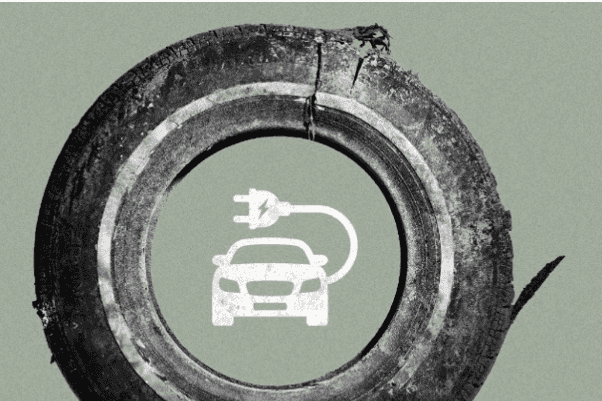EV vehicle sales have increased, but the tire industry needs to address a serious pollution issue.
As a car’s only point of contact with the road, tires do more work than they get credit for. Tires need to grip the road firmly enough for cars to accelerate, turn and brake without skidding, but they also need to reduce rolling resistance enough to maintain fuel efficiency. For tire manufacturers, creating the perfect tire — one that balances performance and durability — is an unending task. In recent years, their work has been further complicated by electric vehicles (EVs)
Due to their bigger batteries, EVs tend to be significantly heavier than their internal combustion engine counterparts. Volkswagen’s e-Golf, for example, is about 400 kilograms (882 pounds) heavier than the gas-powered Golf VII. That added weight rests on the car’s tires, so EVs need tires that are sturdier. This figure may not seem like such a big deal except when you compare it to the Electric Hummer which weighs in at a whopping 4500 Kilograms (10,000 pounds).
EVs also tend to have more torque than combustion engines, which their tires need to be able to transfer to the road within seconds.Leading tire manufacturers are working on improving tire designs and innovating new chemical formulas to meet the needs of EVs. Some brands have introduced products specifically for use on battery-run vehicles, whereas others say they have adapted all of their tires to perform better for both EVs and combustion engine vehicles.
“We have been optimizing our product range for a long time, especially in terms of service life, rolling resistance and rolling noise — factors that are of particular benefit to electric vehicles,” a spokesperson for tire maker Continental was quoted as saying.
How Tires Cause Pollution
Considering the environmental impacts of cars, the focus tends to be on air pollution in the form of exhaust coming out of tailpipes. But tires contribute significantly. Tires wear down over time — with every revolution, they shed tiny particles. The smallest of these pieces go into the air where they can be inhaled or drift off the road to settle on the soil nearby. “Tire use is probably the naughtiest problem for vehicles,” Nick Molden, founder and CEO of Emissions Analytics said. “With a lot of other pollution, you can effectively trap it using some sort of filter or catalyst. But the tire is a fundamentally open system — you cannot encase a tire.”
Emissions Analytics performs independent tests on cars including real-world tailpipe and tire emissions. It has compiled data that confirms that tire particulate pollution has significantly surpassed tailpipe emissions. According to a report shared by Emissions Analytics, a single car sheds 4 kilograms (8.8 pounds) of tire particles weight per year, on average. Multiplied across the global fleet equates to 6 million tons of tire particles annually.
“We measure the amount of solid material that comes out the tailpipe on the road, and we do the same measuring the mass that’s shed by the tires,” explained Molden. “Every year the amount coming from the tailpipe gets lower and lower, and the amount coming from tires is growing because vehicles are getting heavier.” A case study published by Emissions Analytics compared the tire emissions from a Tesla Model Y to a Kia Niro and found that Tesla’s tire wear emissions were 26% greater.
Environmental Hazard
Tire particulate pollution has two primary negative impacts on environmental health. The particulate itself washes into waterways and has been found to be a significant source of oceanic microplastics. Also, tires contain volatile organic compounds (VOCs), which are hazardous to human health, and react in the atmosphere to create smog.
A particularly concerning chemical in tires is 6PPD, which is used to prevent the rubber from cracking or breaking down. 6PPD is also water-soluble, so it is carried off of roads by rain and washed into rivers and oceans where it has been linked to mass salmon and trout die-offs. Further studies found that 6PPD is absorbed by edible plants like lettuce and that the compound can be found in human urine.”It’s the tire industry’s mission to secure a safe comfortable journey with peace of mind, and thus the addition of 6PPD to tire rubber is currently indispensable,” tire maker Bridgestone said in an interview.
Can The Tire Pollution Problem Be Solved?
Phasing out fossil fuel-powered vehicles is an urgently needed aspect of mitigating climate change. But if doing so comes with worsening tire emissions, that is also problematic.
“The obvious solution is to be driving and selling fewer cars,” climate activist Tadzio Müller told DW. He added, “The shift toward electric vehicles is meant to convince us that it’s going to save the planet, but of course, it cannot because the problem has always been capitalist growth.” Asked if reducing car use overall is the best solution to tires’ environmental impacts, Molden told DW, “Yes, that would reduce tire emissions. But in terms of the lost economic activity, would that be worth it?”
“It’s better to create a market mechanism where it’s in the interest of the tire companies to invest a lot and come up with the best formulations,” Molden said, adding that currently there is a two to three times difference between certain tires in terms of VOC toxicity. Molden said generally, Europe’s leading tire brands are among the best whereas cheap imports tend to be the worst.
On an individual level, avoiding rapid accelerations and immediate stops can reduce tire wear. It’s also advisable to use tires to the end of their lifespan because new tires shed twice as much particulate during their first couple thousand kilometers.



